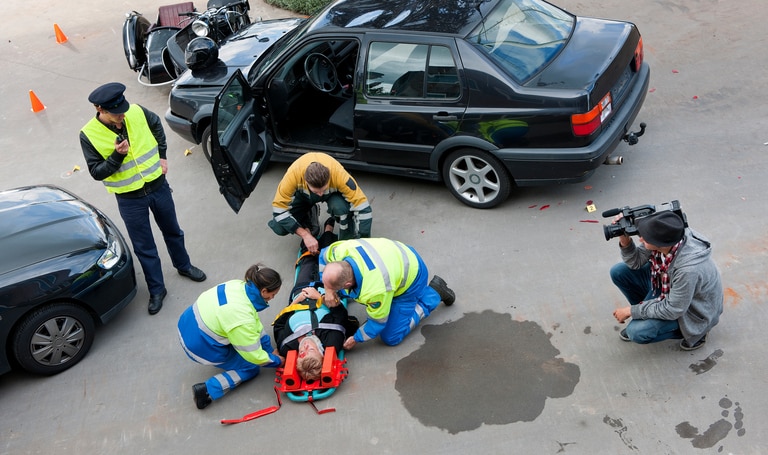
Some would say that there is something inherently thrilling about riding a motorcycle. Perhaps it’s the agility of the bike on the road, or the power you feel when revving the engine. But it’s also likely that this sense of danger which comes with being exposed while riding a fast-moving vehicle comes with knowing that being involved in any kind of accident could be life-threatening – or life–ending.
In this blog, we discuss some of the most common motorcycle injuries and offer some safety precautions to help prevent injury or better protect you in the unfortunate event of an accident.
Motorcycle Accidents and Head Injuries
Motorcycle accidents that cause trauma to the head result in the most serious injuries to riders. Their severity can range from concussions (mild traumatic brain injuries – for more information regarding concussions, see our blog post “Concussions Defined”) to traumatic brain injury and even death.
Wearing a helmet – one that is both designed for motorcycle riders and secured properly – can greatly reduce the potential for harm in the event of an accident. It is the most important motorcycle riding accessory and is required by law – Section 104(1) of the Highway Traffic Act, states that you must not ride a motorcycle or motor assisted bicycle unless you are wearing a helmet that complies with specific regulations..
The Ministry of Transportation for Ontario advises that a helmet must have a strong chin strap and fastener, and be in good condition. A helmet with cracks, or other damage, will not be effective in an accident. Ensure that you select and wear a helmet that is well constructed, fits closely to your head, and has a proper chin strap. Remember, a helmet with full-face protection provides the best protection.
Injuries to Lower Extremities (Legs, Knees, Feet)
Recent statistics for non-fatal motorcycle-related injuries show that the largest percentage of injuries are sustained by a motorcycle rider’s legs, knees and feet. Such injuries include contusions (bruising), lacerations (cuts), sprains, strains, “road rash” (abrasion to the skin arising from contact with the road surface), and dislocation. The more severe injuries tend to be fractured bones (hip, tibia, femur and ankle).
While not guaranteed to prevent injury, protective clothing can help to lessen the severity of injuries to the lower extremities. Protective clothing can also reduce the impact of wind, rain, gravel, grit, dust, dirt and debris, making your rides more enjoyable. Such protective clothing include:
- Pants which fit closely and cover your legs completely (even in warm temperatures). According to the Ministry of Transportation for Ontario, leather offers the best protection and specialized motorcycle riding suits constructed of synthetic materials, like Kevlar, provide a high degree of protection;
- Knee pads worn inside or outside pants;
- Boots that are strong, versatile, and sit high enough to protect your ankles. The soles of your riding boots should be constructed of a hard, durable material that will grip the road surface when stopped. Never wear high heels or shoes with laces or rings which may become entangled in the motorcycle’s controls or engine components.
Injuries to Upper Extremities (Arms, Elbows, Wrists), Torso, Spine
Injuries to a rider’s upper extremities, torso, or back typically occur in situations when a rider:
- attempts to break a fall;
- is thrown from a motorcycle;
- is caught between the motorcycle and a car;
- sustains a head injury or;
- when positioned underneath the motorcycle as it slides along the road surface.
Upper extremity and torso injuries include contusions, lacerations, “road rash”, dislocation, fractured/broken bones (shoulder, elbow, wrist, finger, clavicle, ribs, pelvis), and injuries to internal organs such as lungs and kidneys.
Spinal injuries occur in some or all of the cervical (upper), thoracic (mid), and lumbar (lower) regions of the back. Injuries to the cervical spine range from whiplash (soft-tissue injury) to quadriplegia (complete paralysis from the neck down). Thoracic spine injuries are less common, but can result in paraplegia (paralysis of the legs), loss of sensation, and dysfunction in the bowels and bladder. These last two injuries are common to the lumbar spine as well.
As with lower extremity injuries, protective clothing is the best way to help avoid or reduce the severity of injuries to upper extremities, the torso, or back/neck. Such protective clothing include:
- A jacket which fits closely, completely covers your arms, and is made from leather or a strong synthetic material. Almost all motorcycle jackets incorporate shoulder armour and the Ministry of Transportation for Ontario recommends that you wear a back/neck protector, kidney belt, and body armour inserts for your chest. Be sure not to wear a jacket that has strings, tassels, or loose parts which may become entangled in the motorcycle’s controls or parts.
- Gloves properly sized to your hands provide you with a better hold on handgrips and controls, and, more importantly, protect your hands from potential injury. When selecting gloves, ensure that they are “gauntlet” style which extend over your wrists, are made from strong leather or synthetic material, and are designed for motorcycle use.
All The Gear, All The Time
Motorcyclists should try to remember the ATGATT acronym – All The Gear, All The Time – when preparing to ride. While riding can be thrilling, taking some precautions will be well worth it if you are ever involved in an accident. Motorcycle injuries can take a daunting physical and emotional toll on both the rider suffering from the injuries and their loved ones.
Motorcycle safety has become a growing concern for Toronto Police, especially after the July 10-11, 2017 weekend. This weekend Ontario had a number of motorcycle accidents, one claiming the life of a young female motorcyclist who’s motorcycle got stuck under a car that was making a U-turn.
While the legal landscape can feel isolating and overwhelming, if you or a loved one has been injured in a motorcycle accident, you are not alone. Contact Howie Sacks and Henry LLP. Our lawyers are as experienced and compassionate, and will help you through every step of the legal process. If you have sustained injuries as a result of a motorcycle accident, you may be entitled to compensation for lost income, medical expenses, surgery, future medical costs, and for pain, suffering, and emotional and/or psychological effects..
If you have any questions about an accident you were injured in, please contact one of our personal injury lawyers at 1-647-796-0088.





